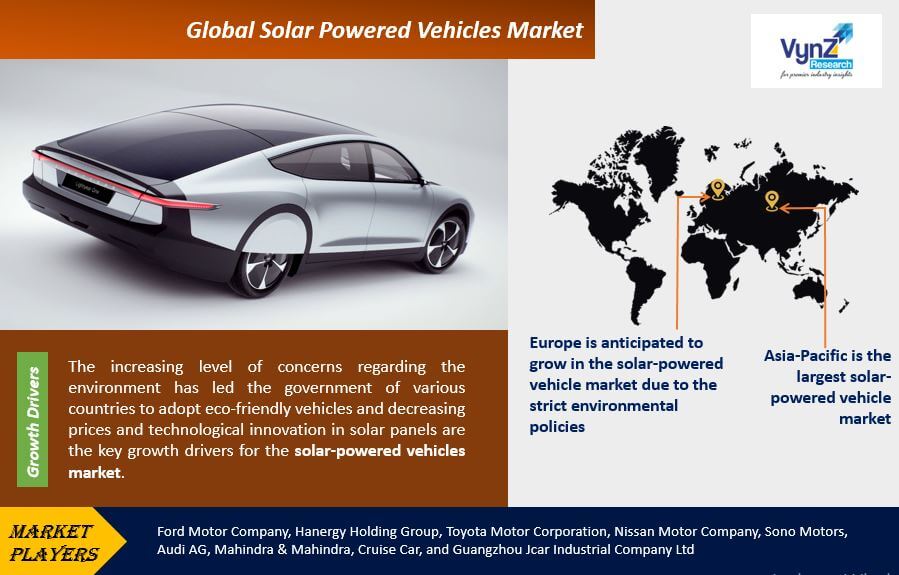| Status : Published | Published On : Dec, 2023 | Report Code : VRAT4019 | Industry : Automotive & Transportation | Available Format :

|
Page : 209 |

Global Solar Powered Vehicles Market – Analysis and Forecast (2025-2030)
Industry Insights by Electric Vehicle Type (Fully Electric Vehicles, Hybrid Electric Vehicles (HEV), and Plug-in Hybrid Electric Vehicles (PHEV)), by Vehicle Type (Commercial Vehicles and Passenger Cars), by Type (Three Wheelers and Four Wheelers), by Battery Type (Lithium-Ion, Lead-Acid, and Lead-Carbon), and by Solar Panel (Monocrystalline and Polycrystalline)
Industry Overview
The Global Solar-Powered Vehicle Market was valued at USD 0.29 billion in 2023 and is anticipated to reach USD 2.85 billion in 2030, registering a CAGR of 37.56% during the forecast period 2025-2030. Solar-powered vehicles are a type of electric vehicle that is partially or completely powered by solar energy as a fuel for propulsion. It is equipped with photovoltaic cells which convert solar energy into electrical energy and are stored directly in the battery of the vehicle.

The global solar-powered vehicles market is growing at a significant rate, due to technological advancement, low maintenance and operating costs of solar vehicles, and rising demand for an efficient vehicle with zero carbon emission. Moreover, environmental degradation caused due to air pollution, fossil fuel exhaust, and emissions from internal combustion engines has led the government to take initiatives in shifting towards clean and renewable energy sources.
The COVID-19 pandemic has affected many economies and companies are facing unprecedented losses. Owing to the spread of the novel coronavirus, the government announced a strict lockdown and there are no operational activities in the industries. The regulatory authorities of various countries such as China are finding relaxation of emission mandates as auto manufacturers have less funding which is the key issue for cost reduction and technological development of solar vehicles. However, there are initiatives taken by the government also, to bring the economy back and start industrial activities.
Solar Powered Vehicles Market Segmentation
Insight by Electric Vehicle Type
Based on the electric vehicle type, the solar-powered vehicle market is segmented into fully electric vehicles, hybrid electric vehicles (HEV), and plug-in hybrid electric vehicles (PHEV). Among all electric vehicle types, the fully electric vehicle segment is expected to grow at a faster rate in the market due to the rising support from the government in the mode of subsidies and incentives.
An electric vehicle encompasses electric motors and the accumulation of energy in rechargeable batteries. Moreover, hybrid vehicles contain two types of power i.e. the internal combustion engine (ICE) and electric motors to power the vehicle electrically.
Insight by Vehicle Type
Based on the vehicle type, the global solar-powered vehicle market is segregated into commercial vehicles and passenger cars. Among all the vehicle types, passenger cars accounted for the larger share in the solar-powered vehicle market owing to the increase in purchasing power of consumers, changing lifestyles and preferences, rising demand for fuel-efficient vehicles, and mounting environmental awareness among consumers. Moreover, the rise in investment by OEMs in R&D activities for producing cost-effective solar vehicles is anticipated to drive the growth of solar-powered passenger cars.
Insight by Type
Based on the type, the market is bifurcated into three-wheelers and four-wheelers. Of these two types, the four-wheeler segment is anticipated to grow at a faster rate in the market due to the rise in the adoption of solar panels in passenger cars and buses.
Insight by Battery Type
Based on the battery type, the global solar-powered vehicle market is divided into lithium-ion, lead-acid, and lead-carbon. The lithium-ion segment is expected to hold the most significant CAGR during the forecast period due to the highest power conversion ratio and smooth charging cycle owing to high energy density with rapid discharging capability, good high-temperature performance, and excellent specific energy (140Wh/kg).
Insight by Solar Panel
Based on the solar panel, the market is divided into monocrystalline and polycrystalline. Among both segments, the monocrystalline segment is anticipated to witness the largest market share as it has a long life span, space-efficient nature, and high efficiency as compared to other types of solar panels.
Global Solar Powered Vehicles Market Report Coverage
|
Report Metric |
Details |
|
Historical Period |
2018 - 2023 |
|
Base Year Considered |
2024 |
|
Forecast Period |
2025 - 2030 |
|
Market Size in 2024 |
U.S.D. 0.29 Billion |
|
Revenue Forecast in 2030 |
U.S.D. 2.85 Billion |
|
Growth Rate |
37.56% |
|
Segments Covered in the Report |
By Electric Vehicle Type,By Vehicle Type,By Type,By Battery Type ,By Solar Panel |
|
Report Scope |
Market Trends, Drivers, and Restraints; Revenue Estimation and Forecast; Segmentation Analysis; Impact of COVID-19; Companies’ Strategic Developments; Market Share Analysis of Key Players; Company Profiling |
|
Regions Covered in the Report |
North America,Europe,Asia-Pacific (APAC),Rest of the World (RoW) |
Industry Dynamics
Solar Powered Vehicles Market Growth Drivers
The increasing level of concern regarding the environment has led the governments of various countries to adopt eco-friendly vehicles and decreasing prices and technological innovation in solar panels are the key growth drivers for the solar-powered vehicles market. The increase in the sale of electric vehicles i.e. solar cars which are self-charging vehicles is acting as range-extenders, thus boosting the demand for the solar-powered electric market.
Moreover, an increase in the demand for energy-efficient vehicles with zero carbon emission and strict regulations regarding vehicle emission is also driving the growth of the market. For instance, according to the World Health Organization (WHO), global exposure to ambient air pollution leads to 4.2 million deaths every year. In addition, 91% of the world’s population lives in a place where air quality exceeds the WHO guidelines limit.
Technological advancement and escalating trends of vehicle automation are also contributing to the growth of the solar-powered vehicle market. For instance, a technological advancement that substitutes the traditional engine could transform transportation and support the environment by diminishing the requirement for fossil fuel combustion. Moreover, Ford introduced a plug-in hybrid electric vehicle with solar panels on the roof that allow the car to recharge itself.
Solar Powered Vehicles Market Challenges
Enormous R&D funds essential for incorporating technologically innovative and aesthetical solar panels and high manufacturing prices are the major challenges for the growth of the solar-powered vehicles market. In addition, poor charging infrastructure, less operational efficiency, high installation cost, lack of standardization, and stringent rules for the installation of charging stations are also hindering the growth of the market.
Solar Powered Vehicles Market Opportunities
Excessive research in far-field wireless charging technologies and technological development in the field of wireless charging is anticipated to create promising opportunities in the global solar-powered vehicle market.
Solar Powered Vehicles Market Industry Ecosystem
Globally, the manufacturing companies trying to enter the solar-powered vehicle market are required to maintain stringent regulatory standards. Moreover, the high level of capital requirement also poses a major barrier to the entry of new players. This offers an edge to the established players in the industry competition.
Solar Powered Vehicles Market Geographic Overview
Geographically, Asia-Pacific is the largest solar-powered vehicle market due to the increasing prominence of the government to encourage environment-friendly vehicles, the rise in purchasing power of consumers, and the high demand for passenger cars from this region. It is one of the largest markets for electric vehicles. In addition, an increase in the requirement for an efficient vehicle with zero carbon emission, and increasing concern about environmental pollution is also surging growth of the Asia-Pacific solar-powered vehicles market.
Europe is anticipated to grow in the solar-powered vehicle market due to the strict environmental policies, pollution control measures, favorable government support, decreasing battery cost, and economies of scale are the factors that contribute to the growth in the region.
Solar Powered Vehicles Market Competitive Insight
Key players in the solar-powered vehicle market are catering to the demand by collaborating with small players and investing in technologically advanced products globally. Key players are adopting strategies such as mergers and acquisitions, partnerships, and the introduction of new products to maintain a competitive edge in the market.
Toyota Motor Corporation is a Japanese multinational automotive manufacturer headquartered in Toyota City, Aichi, Japan. Toyota is the largest automobile manufacturer in the world, producing about 10 million vehicles per year. It was founded by Kiichiro Toyoda and incorporated on August 28, 1937.
Ford Motor Company is an American multinational automobile manufacturer headquartered in Dearborn, Michigan, United States. It was founded by Henry Ford and incorporated on June 16, 1903. The company sells automobiles and commercial vehicles under the Ford brand, and luxury cars under its Lincoln brand
Recent Developments by Key Players
BMW Group, Ford Motor Company and American Honda Motor Co., Inc. collaborated to create ChargeScape, LLC (a new equally-owned company that will create a single, cost-effective platform connecting electric utilities, automakers and interested electric vehicle customers). ChargeScape will unlock entirely new value that EVs can provide to the electric grid, while enabling EV customers to earn financial benefits through a variety of managed charging and energy-sharing services never before possible with traditional gasoline-powered vehicles, benefiting both EV customers and the electric utility industry in the U.S. and Canada.
MAN Truck & Bus shall be the first European truck producer has launched a small series with a hydrogen combustion engine. The initially planned small series of around 200 units is to be delivered to customers in Germany, the Netherlands, Norway, Iceland and selected non-European countries.
Ford Motor Company, Hanergy Holding Group, Toyota Motor Corporation, Nissan Motor Company, Sono Motors, Audi AG, Mahindra & Mahindra, Cruise Car, and Guangzhou Jcar Industrial Company Ltd are the key players offering solar-powered vehicles.
The Solar Powered Vehicles Market report offers a comprehensive market segmentation analysis along with an estimation for the forecast period 2025–2030.
Segments Covered in the Report
- By Electric Vehicle Type
- Fully Electric Vehicles
- Hybrid Electric Vehicles (HEV)
- Plug-in Hybrid Electric Vehicles (PHEV)
- By Vehicle Type
- Commercial Vehicles
- Passenger Cars
- By Type
- Three Wheelers
- Four Wheelers
- By Battery Type
- Lithium-Ion
- Lead-Acid
- Lead-Carbon
- By Solar Panel
- Monocrystalline
- Polycrystalline
Region Covered in the Report
- North America
- U.S.
- Canada
- Mexico
- Europe
- Germany
- U.K.
- France
- Italy
- Spain
- Russia
- Rest of Europe
- Asia-Pacific (APAC)
- China
- Japan
- India
- South Korea
- Rest of Asia-Pacific
- Rest of the World (RoW)
- Brazil
- Saudi Arabia
- South Africa
- U.A.E.
- Other Countries
.png)
Source: VynZ Research
.png)
Source: VynZ Research
Frequently Asked Questions
Purchase Options
Latest Report
Research Methodology
- Desk Research / Pilot Interviews
- Build Market Size Model
- Research and Analysis
- Final Deliverabvle
Connect With Our Sales Team
- Toll-Free: 1 888 253 3960
- Phone: +91 9960 288 381
- Email: enquiry@vynzresearch.com
Solar Powered Vehicles Market
